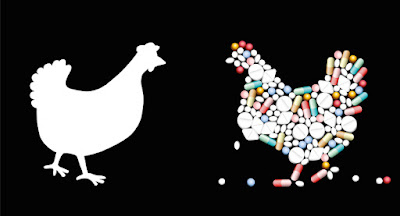Antibiotic free animal farming
Is it possible to raise animals completely antibiotic-free?
Yes, it is possible to raise animals completely antibiotic-free in the poultry industry. However, when an animal is sick and requires an antibiotic, we must do what is necessary to keep animals, humans and our food system safe.
According to Dr. Richard Murphy, while the use of antibiotics in agriculture cannot and should not completely stop due to significant animal welfare implications, this needs to be done judiciously. He says that the industry should look at completely removing antibiotic growth promoters (AGP), and many countries have already introduced policies regarding AGP due to antimicrobial resistance concerns.
 |
| Is it possible to raise animals completely antibiotic-free? |
Dr. Kayla Price, also agrees that the judicious use and reduction of antibiotics in poultry production is here to stay.
“I think it is really important when we are starting to look at general bird health that we make sure we are taking on a holistic approach,” she explained. “Specifically, we really have to think of the intestinal system from hatch to finish.”
Price highlights that there is no one silver bullet solution for removing antibiotics; nutrition and biosecurity are both crucial to ensure success.
Dr. Dulmelis Sandu, states that as stewards to the animals that we grow for food production, it is necessary to ensure that there are options available to support what is best for the animals at each stage of production — some of which may require antibiotic support or intervention.
“It is our responsibility as an industry to provide the right management and best rearing practices to avoid, or at least reduce, the amounts of antibiotics used in animals,” said Sandu. “This is mainly due to the potential implications related to animal welfare, the economic impact related to the expense of antibiotic usage and the overall enhancement of animal health .”
There are many approaches to reduce or eliminate the use of antibiotics from poultry production. A preventative approach, such as using a feed additive program, can help reduce the challenges faced when antibiotics are not used and aid long-term flock health and wellness.
2. Does animal consumption of antibiotics affect human resistance?
According to the National Academy of Medicine, “antibiotic usage in livestock results in the direct spread of antibiotic-resistant bacteria to humans.” Specifically, antibiotic resistance can transfer between bacteria, and these bacteria can move between people, animals and the environment. Even though removing antibiotics from animal production will not stop resistance when considering human misuse of antibiotics, our responsibility is to reduce this risk as much as possible. Regardless of the extent to which animal consumption is connected, we need to focus on strategies that minimize the overall risk of resistance.
Antibiotic resistance has the potential to become one of the greatest challenges of our generation due to the ever-increasing rise in bacterial strains that are progressively less sensitive to existing treatments. A drawback to the use of antibiotics is their non-specific effects on the gut microbiome. In fact, their use can lead to an overall gut microfloral diversity reduction, allowing for the continued proliferation of resistant species. This can have negative impacts on both flock health and performance. One strategy includes using nutritional supplements such as mannan-rich fractions (MRF) to rehabilitate microfloral diversity. This approach will have significant practical value in commercial production and also beneficially impact consumer health and well-being.
3. Could an animal be treated with antibiotics for illness and still go to market?
Yes, even on farms and ranches where they focus on raising animals without antibiotics, if an animal is sick and needs antibiotic treatment, it is separated from the herd and can continue to go through traditional markets. However, a withdrawal period would be required to ensure that no traces of the antibiotic remain in the poultry meat/egg products. In meat production, an animal that has been treated with antibiotics is not put back with the same herd or labeled as raised without antibiotics.
In conclusion, antibiotics can assist in maintaining overall animal production, performance and productivity. In countries that banned antibiotics as a growth promoter in production systems, other alternatives must be explored to meet the population’s growing demand for food. Increased biosecurity and enhanced nutrition are two areas that require attention. Nutrition is critical to ensure the animal’s health and productivity. To protect our animals and our food supply, every producer’s operation will need to place a strong emphasis on providing nutrition that strengthens gut health and immunity.
Tags:
organic farming
